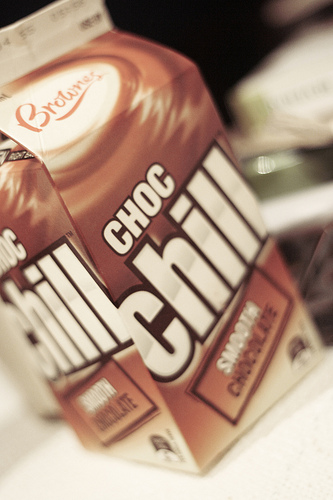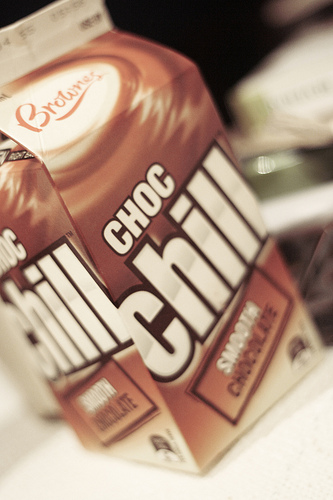 Milk: It does a body sort-of good.Photo: a little tuneD.C. Council Chair Kwame Brown says he’s in possession of “research” conducted by a first-grade pupil that convinces him schools in the nation’s capital should bring back chocolate milk.
Milk: It does a body sort-of good.Photo: a little tuneD.C. Council Chair Kwame Brown says he’s in possession of “research” conducted by a first-grade pupil that convinces him schools in the nation’s capital should bring back chocolate milk.
Brown made the remarks in an animated exchange last week with Kaya Henderson during hearings to consider her confirmation as schools chancellor. Brown said he was impressed by the nutritional information on flavored milk the first-grader had amassed, but more likely, Brown was tagged by the long arm of the dairy industry, which relentlessly pursues efforts to keep flavored milk in schools to offset decades of decline in sales of plain milk. As one of a few major school districts to ditch chocolate milk, the District of Columbia has become a crown jewel for activists aiming to topple flavored milk’s rule in the nation’s lunchrooms. Brown parroted the dairy industry line that kids won’t drink milk unless it’s tarted up with sugar, and will collapse in a heap of osteoporosis and rickets without it.
So how does a 6-year-old dictate school food policy in the nation’s capital? Here’s the transcript from last Thursday’s hearing:
Brown: This is from our youth hearing, a first-grader, and he made sense. And I want him to know to get his question in. We have the Healthy Schools Act. And we all know we want everyone to eat healthy. And I’m all supportive of that. But he had a survey of about I think 100 and something students that he had spoken with and I did my own independent survey of a couple of graduation ceremonies I attended and I come to find out that most students agree. They want to know why they can’t have chocolate milk in the schools. They said they’re getting juices that have more sugar than chocolate milk that has protein and less sugar. And their question to you was to say that it’s not because it’s not part of the Healthy [Schools] Act but because the schools just don’t offer it. And it’s wrong that the schools don’t give them a choice to have chocolate milk anymore. And I want to know can you commit to make sure that we have chocolate milk back in our elementary schools. Because they made an argument that it has protein and calcium and is better than some of the juices they’re getting inside the school now.
Henderson: I got a call from the milk producers of America telling me that research effectively says that if kids don’t drink chocolate milk, they won’t drink milk. I’m happy to work with my food services department on it.
Brown: So we’re going to get chocolate milk back into schools?
Henderson: I will work on it. I mean, here’s the thing, right? We didn’t make that decision lightly. There was a reason.
Brown: I know. I’m not saying …
Henderson: I’m willing to reopen the conversation about chocolate milk.
Brown: We reopened it already. You called and you talked to the milk people and …
Henderson: The milk people called me. That’s the lobbying people [laughs].
Brown: The first-grader came and he did the study and it said that most kids aren’t drinking milk at all now. They’re drinking more juices with more sugar and they’re more inclined at a young age to drink chocolate milk.
Henderson: I’ll talk to my people. Our priority is to have our kids drinking milk.
Brown: Chocolate milk?
Henderson: Why do you all try to get me to get up here and …
Brown: This is an interview, right? We asked you a question and we want to know what you’re committing to.
Henderson: Until I talk to my food service experts, I can’t make that commitment.
Brown: Is anyone here from …
Henderson: No, food services is not here.
Brown: Chocolate milk. Kids won’t drink milk unless it’s chocolate. We want our youth to know when they come to testify, they sit all day long, and he put an incredible amount of work into some of this research and I went to two elementary schools and spoke at their promotional exercises — graduations — and I asked them about chocolate milk and, yes, they want chocolate milk.
Henderson: I’m on it Mr. Chairman.
Brown: Thank you.
Brown’s remarks came as members of the school board in Los Angeles — the nation’s second-largest school district — were voting to eliminate chocolate, strawberry, and other flavored milk as part of that city’s battle against childhood obesity. Schools in Berkeley, Boulder, Minneapolis, and elsewhere also have sworn off flavored milk because of the added sugar it contains. D.C. school officials made the move with little fanfare nearly a year ago after appointing a new food services director who has aggressively redesigned the menu, removing many of the processed and sugary items that had been served daily to the district’s 45,000 students. Nearby Fairfax County, Va., also removed chocolate milk, but then reinstated it to quell protests.
A report by the Institute of Medicine last year found that most Americans do not lack calcium or Vitamin D, refuting claims by the dairy industry that children suffer from a “calcium crisis.” School food guru Ann Cooper, who refers to flavored milk as “soda in drag,” recently said, “we don’t have a calcium crisis, we have an obesity crisis.” In fact, kids in D.C. rank eighth in the nation for being overweight or obese.
The average eight-ounce carton of chocolate milk contains 14 grams — or 3.5 teaspoons — of added sugar, usually in the form of high-fructose corn syrup. The American Heart Association has warned that children on average now consume an astonishing 21 percent of their daily calories in the form of sugar, and as a result exhibit common markers for heart disease, such as low HDL cholesterol, elevated triglycerides, and high LDL cholesterol. Robert Ludwig, an expert in pediatric obesity at the University of California, San Francisco, has called sugar “poison” because of its link to obesity, diabetes, hypertension, and heart disease risk. Ludwig cites a worldwide epidemic of obese infants and fatty liver disorder in children.
No less an authority than Walter Willet, head of the nutrition department at Harvard University, has warned that children should not be served flavored milk in school and that milk itself “is not an essential nutrient.”
As for sugar in fruit juices, the editorial board of the Los Angeles Times last week also wondered why chocolate milk has been getting all the attention, when fruit juice contains as much sugar. The sugar in juice occurs naturally. Still, proposed USDA guidelines [PDF] for school meals would sharply curtail schools’ ability to substitute juice for whole fruit.
Milk is not categorized as a protein in the federally subsidized school meals program. Because of the dairy industry’s special relationship with the USDA, milk comprises its own food group and must be offered with all meals. Protein in school meals comes from other designated sources, such as meat, poultry, and fish. Most schools elect to offer milk as an optional meal selection, but D.C. Public Schools officials, in an effort to speed up food lines, this year required all elementary school students to take milk with their meals. The schools have not released data indicating how much milk children are drinking.
The dairy industry has poured hundreds of millions of dollars into promoting chocolate milk while trying to scare parents, politicians, and food service directors into believing that children won’t grow healthy bones if they do not have access to milk with added sugar and flavorings. The slick industry campaign, including a “Raise Your Hand for Chocolate Milk!” promotion, pays for “studies” that bolster the industry cause, then dresses them up with statements cherry-picked from various health and medical groups to create an impression of widespread approval for kids drinking sugary milk products as much as they like.
Dairy interests have vigorously promoted one “study” in particular purporting to show that milk consumption plummets when flavored milk is removed from school. But that was the product of a marketing research firm hired by the Milk Processors Education Program, which refuses to make the “study” available for public inspection.
For the last year and a half, I’ve been monitoring what kids in the nation’s capital eat in the cafeteria every day and I can attest that they still drink plain milk. Sure, they’d drink more if it were chocolate or strawberry. But we already know kids love sugar. They’d eat lollipops instead of lunch if we let them. Only a year ago, they were pouring strawberry milk over Apple Jacks cereal as part of a breakfast that included Pop-Tarts, Giant Goldfish Grahams, and Otis Spunkmeyer muffins. Kids as young as 5 were regularly being served the equivalent of 15 teaspoons of sugar before classes even started. All that is gone in favor of plain milk, cereal containing no more than five grams of sugar, string cheese, and yogurt.
Still, just in the last week I saw children at my daughter’s elementary school unpacking bottles of Sprite and Pepsi and containers of Kool Aid from lunch boxes they brought from home. I’ve seen kids eat bags of home-brought Oreo cookies, giant cupcakes, huge Hershey’s chocolate bars, and packages of Skittles. I recently witnessed one high-schooler make a lunch out of a 24-ounce bottle of Mountain Dew and a bag of Lifesaver candies.
Conducting my own unscientific survey for this article, I asked my 11-year-old daughter for her opinion. She said all schools should be made of chocolate and jelly beans, security guards should be replaced with giant Gummi Bears, and classes should be held at the Dave & Buster’s arcade at the White Flint Mall. Her 9-year-old cousin, meanwhile, said half of all school hours should be spent in recess, the other half at lunch.
Schools are not free choice zones. Last we checked, adults — not children — were still responsible for making important policy decisions involving curricula, teacher hiring, standards, and a host of other vital school issues — including nutrition and meal service. Local elected leaders are expected to act like grownups and look out for the welfare of minors, not pander to 6-year-olds and the dairy lobby.




